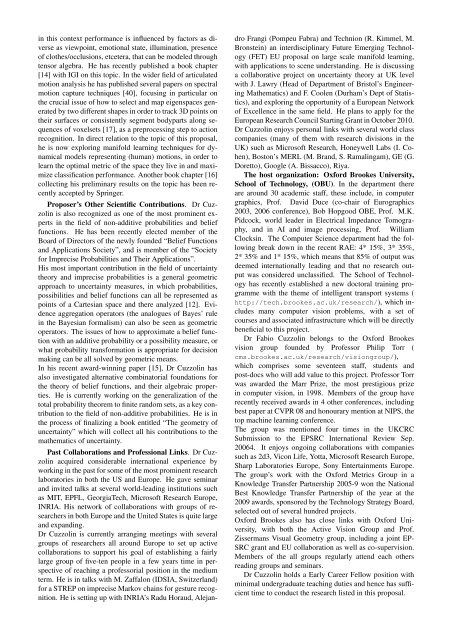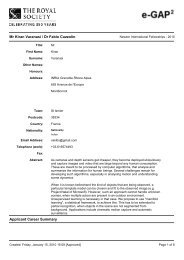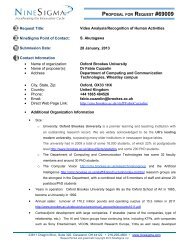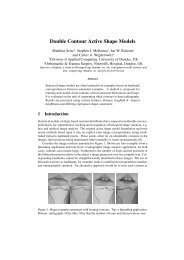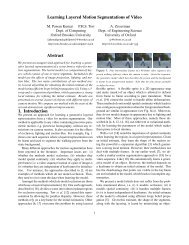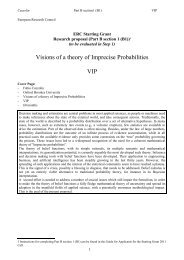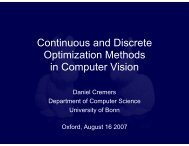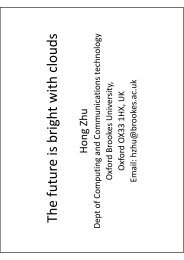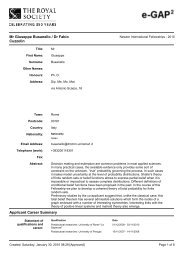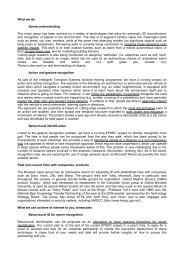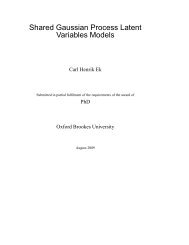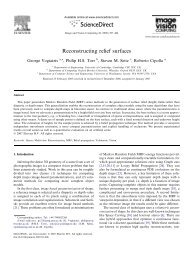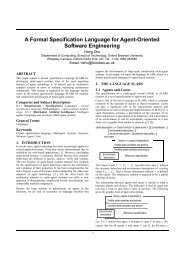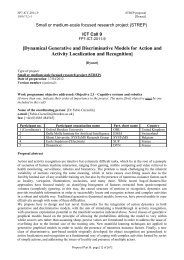Learning manifolds of dynamical models for activity recognition
Learning manifolds of dynamical models for activity recognition
Learning manifolds of dynamical models for activity recognition
You also want an ePaper? Increase the reach of your titles
YUMPU automatically turns print PDFs into web optimized ePapers that Google loves.
in this context per<strong>for</strong>mance is influenced by factors as diverse<br />
as viewpoint, emotional state, illumination, presence<br />
<strong>of</strong> clothes/occlusions, etcetera, that can be modeled through<br />
tensor algebra. He has recently published a book chapter<br />
[14] with IGI on this topic. In the wider field <strong>of</strong> articulated<br />
motion analysis he has published several papers on spectral<br />
motion capture techniques [40], focusing in particular on<br />
the crucial issue <strong>of</strong> how to select and map eigenspaces generated<br />
by two different shapes in order to track 3D points on<br />
their surfaces or consistently segment bodyparts along sequences<br />
<strong>of</strong> voxelsets [17], as a preprocessing step to action<br />
<strong>recognition</strong>. In direct relation to the topic <strong>of</strong> this proposal,<br />
he is now exploring manifold learning techniques <strong>for</strong> <strong>dynamical</strong><br />
<strong>models</strong> representing (human) motions, in order to<br />
learn the optimal metric <strong>of</strong> the space they live in and maximize<br />
classification per<strong>for</strong>mance. Another book chapter [16]<br />
collecting his preliminary results on the topic has been recently<br />
accepted by Springer.<br />
Proposer’s Other Scientific Contributions. Dr Cuzzolin<br />
is also recognized as one <strong>of</strong> the most prominent experts<br />
in the field <strong>of</strong> non-additive probabilities and belief<br />
functions. He has been recently elected member <strong>of</strong> the<br />
Board <strong>of</strong> Directors <strong>of</strong> the newly founded “Belief Functions<br />
and Applications Society”, and is member <strong>of</strong> the “Society<br />
<strong>for</strong> Imprecise Probabilities and Their Applications”.<br />
His most important contribution in the field <strong>of</strong> uncertainty<br />
theory and imprecise probabilities is a general geometric<br />
approach to uncertainty measures, in which probabilities,<br />
possibilities and belief functions can all be represented as<br />
points <strong>of</strong> a Cartesian space and there analyzed [12]. Evidence<br />
aggregation operators (the analogues <strong>of</strong> Bayes’ rule<br />
in the Bayesian <strong>for</strong>malism) can also be seen as geometric<br />
operators. The issues <strong>of</strong> how to approximate a belief function<br />
with an additive probability or a possibility measure, or<br />
what probability trans<strong>for</strong>mation is appropriate <strong>for</strong> decision<br />
making can be all solved by geometric means.<br />
In his recent award-winning paper [15], Dr Cuzzolin has<br />
also investigated alternative combinatorial foundations <strong>for</strong><br />
the theory <strong>of</strong> belief functions, and their algebraic properties.<br />
He is currently working on the generalization <strong>of</strong> the<br />
total probability theorem to finite random sets, as a key contribution<br />
to the field <strong>of</strong> non-additive probabilities. He is in<br />
the process <strong>of</strong> finalizing a book entitled “The geometry <strong>of</strong><br />
uncertainty” which will collect all his contributions to the<br />
mathematics <strong>of</strong> uncertainty.<br />
Past Collaborations and Pr<strong>of</strong>essional Links. Dr Cuzzolin<br />
acquired considerable international experience by<br />
working in the past <strong>for</strong> some <strong>of</strong> the most prominent research<br />
laboratories in both the US and Europe. He gave seminar<br />
and invited talks at several world-leading institutions such<br />
as MIT, EPFL, GeorgiaTech, Micros<strong>of</strong>t Research Europe,<br />
INRIA. His network <strong>of</strong> collaborations with groups <strong>of</strong> researchers<br />
in both Europe and the United States is quite large<br />
and expanding.<br />
Dr Cuzzolin is currently arranging meetings with several<br />
groups <strong>of</strong> researchers all around Europe to set up active<br />
collaborations to support his goal <strong>of</strong> establishing a fairly<br />
large group <strong>of</strong> five-ten people in a few years time in perspective<br />
<strong>of</strong> reaching a pr<strong>of</strong>essorial position in the medium<br />
term. He is in talks with M. Zaffalon (IDSIA, Switzerland)<br />
<strong>for</strong> a STREP on imprecise Markov chains <strong>for</strong> gesture <strong>recognition</strong>.<br />
He is setting up with INRIA’s Radu Horaud, Alejan-<br />
dro Frangi (Pompeu Fabra) and Technion (R. Kimmel, M.<br />
Bronstein) an interdisciplinary Future Emerging Technology<br />
(FET) EU proposal on large scale manifold learning,<br />
with applications to scene understanding. He is discussing<br />
a collaborative project on uncertainty theory at UK level<br />
with J. Lawry (Head <strong>of</strong> Department <strong>of</strong> Bristol’s Engineering<br />
Mathematics) and F. Coolen (Durham’s Dept <strong>of</strong> Statistics),<br />
and exploring the opportunity <strong>of</strong> a European Network<br />
<strong>of</strong> Excellence in the same field. He plans to apply <strong>for</strong> the<br />
European Research Council Starting Grant in October 2010.<br />
Dr Cuzzolin enjoys personal links with several world class<br />
companies (many <strong>of</strong> them with research divisions in the<br />
UK) such as Micros<strong>of</strong>t Research, Honeywell Labs (I. Cohen),<br />
Boston’s MERL (M. Brand, S. Ramalingam), GE (G.<br />
Doretto), Google (A. Bissacco), Riya.<br />
The host organization: Ox<strong>for</strong>d Brookes University,<br />
School <strong>of</strong> Technology, (OBU). In the department there<br />
are around 30 academic staff, these include, in computer<br />
graphics, Pr<strong>of</strong>. David Duce (co-chair <strong>of</strong> Eurographics<br />
2003, 2006 conference), Bob Hopgood OBE, Pr<strong>of</strong>. M.K.<br />
Pidcock, world leader in Electrical Impedance Tomography,<br />
and in AI and image processing, Pr<strong>of</strong>. William<br />
Clocksin. The Computer Science department had the following<br />
break down in the recent RAE: 4* 15%, 3* 35%,<br />
2* 35% and 1* 15%, which means that 85% <strong>of</strong> output was<br />
deemed internationally leading and that no research output<br />
was considered unclassified. The School <strong>of</strong> Technology<br />
has recently established a new doctoral training programme<br />
with the theme <strong>of</strong> intelligent transport systems (<br />
http://tech.brookes.ac.uk/research/), which includes<br />
many computer vision problems, with a set <strong>of</strong><br />
courses and associated infrastructure which will be directly<br />
beneficial to this project.<br />
Dr Fabio Cuzzolin belongs to the Ox<strong>for</strong>d Brookes<br />
vision group founded by Pr<strong>of</strong>essor Philip Torr (<br />
cms.brookes.ac.uk/research/visiongroup/),<br />
which comprises some seventeen staff, students and<br />
post-docs who will add value to this project. Pr<strong>of</strong>essor Torr<br />
was awarded the Marr Prize, the most prestigious prize<br />
in computer vision, in 1998. Members <strong>of</strong> the group have<br />
recently received awards in 4 other conferences, including<br />
best paper at CVPR 08 and honourary mention at NIPS, the<br />
top machine learning conference.<br />
The group was mentioned four times in the UKCRC<br />
Submission to the EPSRC International Review Sep.<br />
20064. It enjoys ongoing collaborations with companies<br />
such as 2d3, Vicon Life, Yotta, Micros<strong>of</strong>t Research Europe,<br />
Sharp Laboratories Europe, Sony Entertainments Europe.<br />
The group’s work with the Ox<strong>for</strong>d Metrics Group in a<br />
Knowledge Transfer Partnership 2005-9 won the National<br />
Best Knowledge Transfer Partnership <strong>of</strong> the year at the<br />
2009 awards, sponsored by the Technology Strategy Board,<br />
selected out <strong>of</strong> several hundred projects.<br />
Ox<strong>for</strong>d Brookes also has close links with Ox<strong>for</strong>d University,<br />
with both the Active Vision Group and Pr<strong>of</strong>.<br />
Zissermans Visual Geometry group, including a joint EP-<br />
SRC grant and EU collaboration as well as co-supervision.<br />
Members <strong>of</strong> the all groups regularly attend each others<br />
reading groups and seminars.<br />
Dr Cuzzolin holds a Early Career Fellow position with<br />
minimal undergraduate teaching duties and hence has sufficient<br />
time to conduct the research listed in this proposal.


